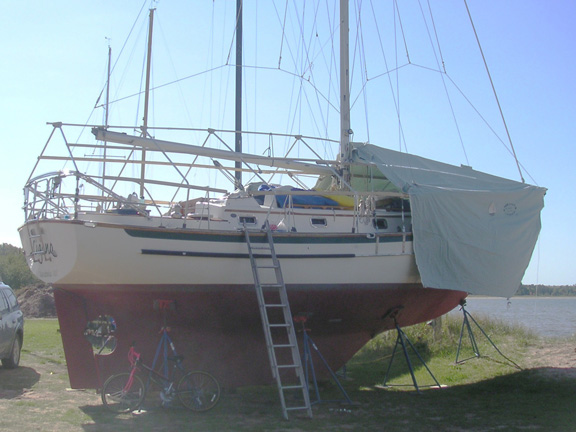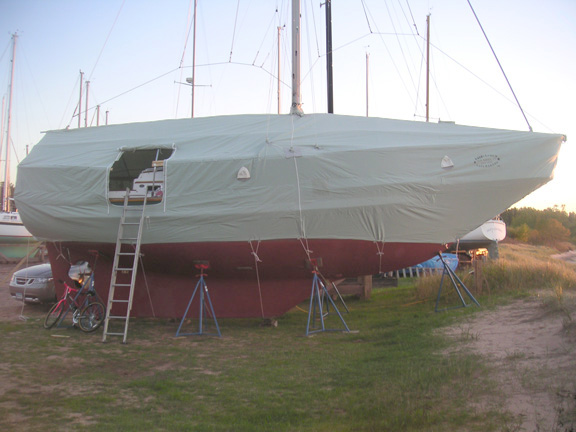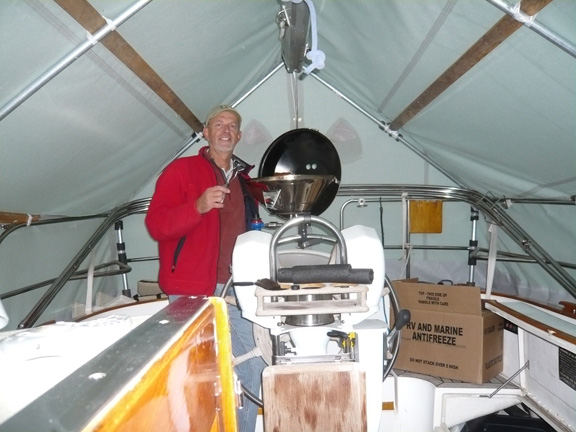Their cover is breathable light green cotton duck and has sewn-in vents so a fair amount of both light and air get through. The standard configured cover we ordered goeas all the way below the waterline, so this version is suitable for on-land storage, not in-water use. The quoted price included everything - steel framing, connectors, wooden stringers, fasteners, cord, tape, etc, and freight.
The steel frames (1" dia galvanized conduit) sit inside the caprail on rubber crutch tips but arc outside and above the lifelines creating lots of space. They attach to adjustable cast fittings along a center ridge pole which takes a bend around the mast. Two sets of wooden stringers run fore and aft on each side. The two fore and aft pieces of the cover zip together at the mast and zip over each shroud with collars for everything. There is also a zipper/collar for the staysail stay and one zip open door is standard on what ever side you want. Fairclough recommends tying your halyards, topping lifts, etc. to the mast or shrouds, but I attached them to rope arches (see photo) with loops for each halyard, etc. that I tied between forestay, mast, and backstay. By doing that I eliminated noise and nearly all chafing except at the sheaves.
The ends of the cover are laced shut with cord through grommets and the bottom edges are tied off under the hull and keel. The booms are hung from the frame inside the cover giving extra mass to the whole structure and there is TONS of room. It is a very solid structure and to their credit, everything fit correctly.
They have options for things like two doors, boat in water, mast down, davits, radar masts, etc. If you want to get a quote for your boat you can probably pick yours from their list. They must have a thousand boat designs or more listed for which they already have patterns.
There is a marginal video on their web site that describes the installation process, and a downloadable instruction booklet that is more comprehensive.
It took almost as long to unpack and sort everything out as it took to install the frame. I put the frame and cover up myself for the first time with the boat on stands . . . no problems except the cover was tough to handle with the wind blowing 15-25 knots all day. Their fittings were easy to adjust and I expect that next year I will be able to install it in half a day - weather permitting.
Fairclough claims the cover should last 12 years. I can't personally vouch for longevity, but our friend is very happy with his that came with his Shannon 38 - the cover is 15 years and still in good shape.
Our cover may have cost more than others but when we compare other covers we've seen we think it's worth the $. And with all the negatives and cost associated shrink wrapping, that was not an option. Our favorite feature is the space. We can store everything we want (sails, dinghy, fenders, lines, canvas, and everything else) up on the coach roof under the big canvas garage, leaving the cabin, lockers, decks, etc. wide open for work. Secondly there is a reasonable amount of room to work under the cover on deck. We can stand on the cockpit seats. The only area where work space is highly limited is at the bow, where the vertical height drops to the height of the bow pulpit. This confined space also makes it rather difficult to install and lace closed that section of the cover from inside.
Nevertheless, so far, we would recommend this cover to anyone, although we know of another Cabo Rico 34 owner who was unable to get Fairclough to build a cover with some custom openings for gallows and davits. That would seem easy to me but who knows? We'll see how we feel about it after after a few years.
May 2007 - Comments after the first winter under the cover: Our boat faced west and was only 20 yards from the beach and completely exposed high above the sand dunes. The cover and frame withstood very strong winds and direct exposure to the NW - NE angle from which Lake Superior's strongest winter gales blow. Working under the cover this spring was easy and warm out of the wind.
The cover shows visible chafing in a few areas which we will have to reinforce. Our biggest issue is that we had chafing along our rub strake because the slightly prominent oval-head screws that fasten the S/S edging caused dime-sized chafing spots over each one (every 6 inches). An option would have been to cover the rub strake with something to protect the cover - maybe a piece of split foam used for insulating plumbing or even some tape. We thought that Fairclough should have been aware of the likelihood of this and sewn in chafing strips accordingly.
June 2007 Fairclough offered to sew on the rub strake chafe strips and take care any other visible chafing areas for $250 - reasonable.
August 2007 We decided to ship the cover back to Fairclough to have the above work done. They finished the job quickly and freight was included in their quote. They did a good job and also added chafe patches and strips to other areas that showed signs of chafe from last season. We wish rub strake chafing strips would have been sewn on initially to avoid extra handling but this was a good solution. According to Fairclough the prominent screws fastening our s/s rub strake edging are not common to every CR34 so the problem was not foreseen.
October 2007 The cover went on in half the time this year. The wind was light and having one season's experience, it was easy. If I had a helper, I could have cut the time in half again. This year I fitted foam pipe insulation strips over our rub strake for added chafe protection. Since the cover appears to shrink when wet, it is important to lace the ends shut when the cover is dry. As I found out when I loosened the aft lacing, the cover was impossible to lace completely closed after the rain came down for several hours and tightened everything up. I am very satisfied with the cover. My only regret (my own fault) is that we did not spring for a second door to open up more air-flow on hot days when I work under the cover.
November 2007 This month we heard from an acquaintance that they were unhappy with Fairclough's service. They ordered a cover and discussed all the issues with the sales staff, being careful to mention several times their special needs, including provisions for gallows and davits. Faircluogh promised that everything would be easy and said "we do this all the time". Fairclough even came and took measurements and assembled the frame in preparation. But when it came time to complete the job, Fairclough was unwilling to perform the extra work they promised and the job ended. It was too late in the season to contract with another company. I know stories like this have two sides - this is only the side of the customer. But customers are what make a company viable and it seems there could have been a better solution.
Spring 2008 The cover did well again, except for a small area of chafing through a chafing protection strip which we will have to address next fall. Winter winds were nasty this past year.
Helpful Hint passed on from our friend Dennis: Store the cover (dry) in a large covered garbage can(s) to keep the critters out.
Oct 2008 The cover went on in about three hours thanks to the help from my son. This is one case where the whole is much greater than the sum of its parts.
May 2014 We are going into our ninth season - eight winters on the cover and it is holding up just fine. It was a great choice for many reasons. I will reiterate that I wish I had installed a door on both sides for convenience, visibility, and for cross ventilation on occasional hot days.
Sept 2014 While pulling "too hard" trying to fit the cover, I ripped out an 18" section of seam near the bow in a critical spot - no time for professional help so I sewed it closed it by hand. It's nearly 10 years old - go figure - I suppose the thread is beginning to weaken from the winter torture. I'm pretty certain it still has a long way to go before it self destructs but some seams may need attention soon.
Oct 2016 We had all cover seams restitched over the summer. We are aiming for no more rips. The sun, even way up here in the north, really does a number on the threads, both on the cover and boat canvas in general.



